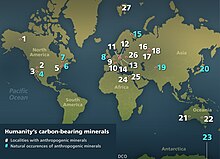Tinnunculite
| Tinnunculite | |
|---|---|
| General | |
| Category | Organic mineral |
| Formula (repeating unit) | C5H4N4O3 · 2H2O |
| IMA symbol | Tnn[1] |
| Crystal system | Monoclinic |
| Crystal class | 2/m - prismatic |
| Space group | ' |
| Identification | |
| Color | White |
| Tenacity | Earthy (dull) |
| References | [2] |
Tinnunculite is a naturally-occurring form of dihydrate of uric acid. It should not be confused with a proposed mineral species with the identical name 'Tinnunculite', that forms when droppings from a European kestrel react with the burning dumps of coal mines and quarries. The name tinnunculite is derived from the kestrel's binomial name, "Falco tinnunculus", which is itself derived from the Latin word tinnunculus, meaning "kestrel", from tinnulus, meaning "shrill".[3] Tinnunculite is a naturally occurring form of the same type of origin.
The mineral is a dihydrate of uricite to which it is visually very similar. Tinnunculite is chemically similar to other organic minerals: guanine, uricite; also acetamide, kladnoite.[2] A new mineral proposal with the same name but slightly different formula (C10H12N8O8) was submitted by Chesnokov & Shcherbakova and ultimately rejected by the International Mineralogical Association (IMA) on the basis of being of anthropogenic origin.[4]
Localities
Russia: Mount Rasvumchorr, Khibiny Massif, Kola Peninsula, Murmanskaja Oblast, Northern Region.

References
- ^ Warr, L.N. (2021). "IMA–CNMNC approved mineral symbols". Mineralogical Magazine. 85 (3): 291–320. Bibcode:2021MinM...85..291W. doi:10.1180/mgm.2021.43. S2CID 235729616.
- ^ a b "Tinnunculite: Mineral information, data and localities". Archived from the original on 11 June 2024. Retrieved 31 January 2017.
- ^ Jobling, James A (2010). The Helm Dictionary of Scientific Bird Names. London: Christopher Helm. pp. 266, 386. ISBN 978-1-4081-2501-4.
- ^ "Tinnunculite (of Chesnokov & Shcherbakova)". Mindat.org. Archived from the original on 30 March 2017. Retrieved 31 January 2017.
